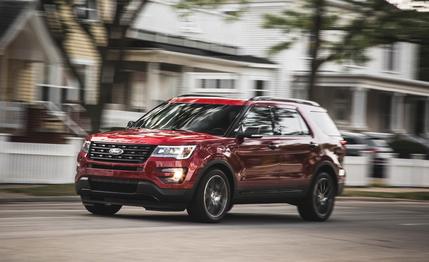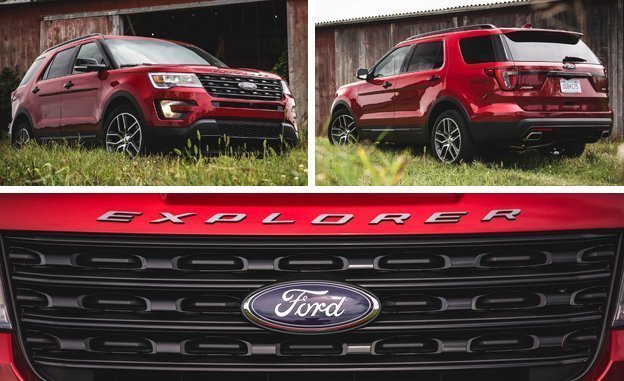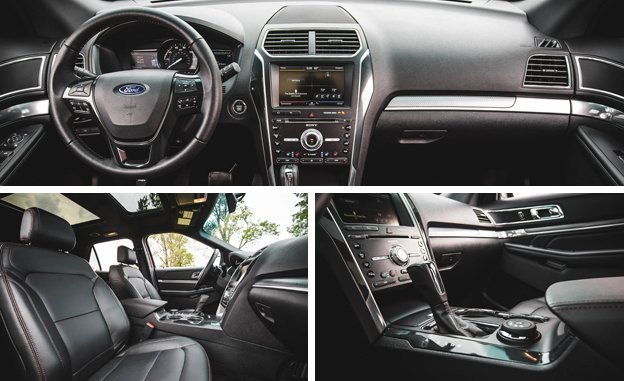 Instrumented Test
Instrumented Test
Ford likes to tout the 2016 Explorer as the sixth-generation model. As inveterate quibblers, we’d suggest the reasoning behind that claim has more to do with eligibility criteria for various new-car awards than with the hardware on the showroom floor. It may be a quarter-century since the Explorer pretty much launched the whole SUV craze, but the 2016 rides on the same platform—one it shares with the Taurus and the Flex—as it has since 2011 when Dearborn made the big leap from body-on-frame truck to unit-body crossover and called it the fifth-generation.
Ask Ford people what’s really new, and you find out the 2016’s wheelbase measures 0.2-inch longer due to a minor suspension tweak, while the new nose (fascia, hood, and front fenders) adds another inch or so of overall length. The suspension layout—struts up front and a multilink rear—is the same, although freshly tuned for the new model year. Redesigned front and rear styling and several welcome equipment upgrades help the Explorer fend off newer competitors while broadening its appeal, but all that makes it a better SUV, not a new one.
So there’s little surprise to discover that the Explorer Sport, our favorite among the previous model offerings, performs pretty much identically to the old one. We’d harbored hopes for a little more, based on Ford’s claims that the addition of a new, high-end Platinum trim level had freed its engineers to make the Sport a bit, well, sportier. It certainly looks the business with its blacked-out trim and grille outside and perforated leather with red stitching inside.
What makes the Sport worth a starting price $12,450 higher than the base Explorer and $2200 beyond the Limited is its 3.5-liter EcoBoost V-6, which makes 365 horsepower and 350 lb-ft of torque. Previously seen only in the Sport (and in Police Interceptor Utilities, a version Ford doesn’t call an Explorer), this mill now also powers the new Platinum model. All-wheel drive is standard, as is the same six-speed automatic as before, with paddle shifters for those with delusions about what a Sport badge can do for a 5000-pound, three-row SUV.

The 2016 Sport gets to 60 mph in 6.0 seconds flat, a tenth behind the version we tested in 2013, and it ran the quarter-mile in 14.6 at 96 mph. Nevertheless, it’s still measurably quicker (by 0.4 seconds to 60 mph) than a Dodge Durango R/T with the 5.7-liter Hemi V-8.
Likewise on the skidpad (0.83 g versus 0.84 in 2013), nothing has really changed. Except that this car was riding on optional summer-only Continental tires, whereas the earlier one was on the standard all-season Hankooks. If that change paid off, it was in braking, where the 2016 model needed only 166 feet to stop from 70 mph, 11 fewer than the earlier example. Our tester noted moderate fade over repeated stops, not unusual when such heavy vehicles are asked to perform at this extreme, but distances shortened again when the brakes were allowed to cool.
Ford touts the Sport’s suspension tuning and quicker steering ratio as other attributes tailored to the driving enthusiast’s tastes. The electrically assisted steering system’s ratio hasn’t changed from the 15.8:1 it was on the previous Explorers. What has changed is that the Sport is now the only Explorer using this gear; all other versions have moved to a 17.1:1 ratio. Ford backs into the explanation when boasting that the newer, slower ratio that’s good enough for non-Sport Explorers is “more linear and predictable.” And that makes the Sport’s steering gear what, exactly? Mostly, it just means the Sport is tuned for sharper initial turn-in response. Its stiffer spring and damper-absorber tuning allows for that without an alarming amount of initial roll to go with it, although canyon-carving isn’t in this SUV’s nature.
In the real world of cut-and-thrust commuting, the Sport’s steering feels sharper in lane-change maneuvers. Oh, and add 0.2 feet to the turning circle, bringing the Sport up to a full 40-foot diameter. Overall, though, the Sport label really means more power with trimmings that are less glittery than those of the Platinum.

To Ford’s credit, this Explorer has a comfortable, non-jarring, and quiet ride even over the cratered apocalypse that passes for roads near our Ann Arbor base. So the stiffer tuning of the suspension isn’t all that stiff, but it’s also noteworthy in that the Sport has standard 20-inch wheels with 50-section tires. Most competitors ride this well only when the wheel size is constrained to 18 inches or so. Eighteen inches also is, coincidentally, the size of the steel rims Ford installs on the Police Interceptor, which also gets the whole heavy-duty-this, more-rigid-that treatment and also sits more than an inch lower (before any light bar, of course). If you wanted to turn a Sport into something more aggressive, find someone who can buy you the parts out of the cop catalog—they’re the only ones getting the real performance goods.
For the more ordinary sort of options, tick box 401A to inflate the sticker by 10 percent ($4300). This gets you a package that includes voice-activated navigation via Sync with MyFordTouch (a generation, ahem, behind the latest technology in Dearborn’s toy box—Ford promises the latest, much-improved version of Sync comes next year), plus inflatable outboard rear seatbelts, blind-spot monitoring, a tailgate that opens when you kick your foot under it (seen previously in the Escape), a power tilting/telescoping and heated steering wheel, and a front camera (the rear camera is standard—they have washers on ’em this year). Add $1150 and your forward-looking systems will include adaptive cruise control and collision warning. The dual-panel sunroof added $1595 to our test car, allowing our second-row passengers (two, in the bucket seats, a $695 option) to look at the sky. They might wish for DVD screens in the back of the front headrests, the costliest option ($1995) that this vehicle lacked. A few more indulgences, like Ruby Red metallic paint ($395), and soon this family hauler costs more than $53,000. But, you know, Class III towing (up to 5000 pounds) is standard. And the character lights on both ends are LEDs. And so on. New flavors of jam spread on a familiar crumpet, but tasty stuff all the same.